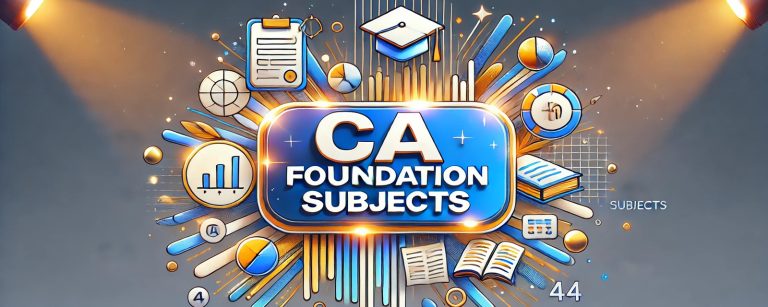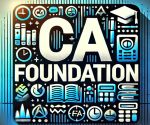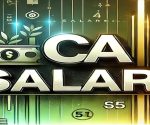The CA Foundation syllabus is based on three areas: Accounting, Business Law, Mathematics, and Economics. This foundation serves as a starting point for the more advanced stages of the Chartered Accountancy course. According to the directives of the Institute of Chartered Accountants of India, this CA Foundation course prepares candidates to master skills, which in turn will help them clear Intermediate and Final levels. The theoretical and practical concepts are available in the syllabus, which will enable students to understand everything accordingly. So, if you are appearing for the CA Foundation in 2025, you have to know all about the syllabus in depth to frame up your preparation properly and get the desired results. So, it covers the article of CA Foundation Syllabus 2025 along with Subject-Wise topics, changes made in the 2025 syllabus, and preparing how to get a better score.
What is CA?
CA Fullform is a Chartered Accountant. This is a professional program to deal with complex financial and tax issues. Students will master an in-depth understanding of accounting principles, auditing, tax law, and corporate finance. business regulations, etc. Competence is the most valuable thing in the world for a financial professional.
The course CA is operated by ICAI, wherein the student obtains both theoretical as well as practical knowledge. So, it will have three stages:
- CA Foundation: The first and entry-level to start with the course for the students after completion of class XII.
- CA Intermediate: IPCC It is the mid-level course that is available to the students, who have successfully cleared the foundation exam or taken through the direct entry route at the end of graduation.
- CA Final: It is the last and highest level of the course.
- Besides passing such tests, students have to undergo 3-year training in Articleship. This practical exercise gives real exposure to students dealing with accounting, auditing, and taxation; hence empowering them for a proficient career.
The CA qualification is very diversified because it provides options for practice in various industries like corporate finance, public practice, or even entrepreneurship.
CA Foundation Course 2025
The CA Foundation program covers the study of basic knowledge in accounting, business law, economics, and mathematics. Changes in the financial world have meant an update on the syllabus for 2025 to get a contemporary version of these areas.
The CA Foundation exam pattern comprises a mix of subjective (descriptive) and objective (MCQ-based) papers, so the students are tested on both conceptual clarity and analytical skills. The total number of papers is four, each worth 100 marks. Two of them are subjective, requiring written answers, and the other two are objective with negative markings for wrong answers.
The CA Foundation course gives an adequate academic foundation but tests a student’s ability to solve problems. It gears them up to face the rigors of the Intermediate and Final levels.
| Aspect | Details |
| Total Papers | 4 |
| Exam Mode | Offline (Pen-and-Paper) |
| Paper Format | 2 Subjective and 2 Objective |
| Marks per Paper | 100 |
| Negative Marking | Applicable in Objective Papers Only |
| Passing Criteria | Minimum 40% in each paper and 50% overall |
| Exam Frequency | Three times a year (May, August, November) |
CA Foundation Exams Sessions
From 2025, ICAI has taken the significant change to conduct CA Foundation exams thrice a year. So far, this exam has been held twice, i.e., in May and November. The new third session in August provides more comfort for students while deciding the exam date. CA Exam Date 2025 Schedule for May Session The CA May Foundation exam will be conducted from May 15 to May 21, 2025, for all 4 papers. CA May Inter exam will be conducted from May 3 to May 14, 2025, for 2 groups on different days. CA May Final exam will be conducted from May 2 to May 13, 2025, for all 2 groups on different days. The International Taxation Assessment Test will take place between May 10 and 13. The schedule of three sessions of CA Foundation Exams for the year 2025 is as follows:
- May 2025 Session: Ideal for students completing their Class XII exams in May from May 15 to May 21, 2025.
- August 2025 Session: Provides ample preparation time to the students who fail to get in May.
- November 2025 Session: This session is perfect for those requiring more preparation time and also failed to register in previous sessions.
It minimizes the re-appears waiting time for the students. It helps for faster progress within the CA course. The choice of an appropriate exam session based on preparation requires registration well before the exams take place.
CA Foundation Subjects
A Foundation Topics The CA Foundation Level is the entry-level into the Chartered Accountancy course. Its purpose is to introduce students to the basic principles of accounting, business, and economics. This helps lay the foundation for creating complex themes later on. The CA Foundation curriculum is divided into four main topics
Paper 1: Principles and Practice of Accounting
Accounting is the backbone of the CA curriculum. Thus, this paper aims to familiarize the student with basic accounting principles. This shall cover the basis of financial accounting and its applications in business. This paper requires students to acquaint themselves with a semblance of journal entries, ledger accounts, preparation of trial balances, and preparation of financial statements. The syllabus includes basic concepts about accounting principles, conventions, and assumptions that form a basis for further advanced accounting. The topics learned include partnership accounts, consignment accounts, bills of exchange, and other topics that include inventory valuation, depreciation accounting, and rectification of errors.
The important aspects of this paper include final accounts of sole proprietorships, non-profit organizations, and partnership firms. In addition, students learn to prepare accounts for incomplete records, which is an important aspect of practical accounting situations. Students master this paper with clarity regarding how financial transactions are recorded and reported, an essential skill of any accountant.
| Chapter | Weightage (%) | Subtopics |
| Theoretical Framework | 5-10% | – Meaning and Scope of Accounting |
| – Accounting Concepts, Principles, and Conventions | ||
| – Types of Accounts | ||
| Accounting Process | 20-25% | – Journal Entries |
| – Ledger and Trial Balance | ||
| – Rectification of Errors | ||
| Bank Reconciliation Statement | 10% | – Preparing BRS |
| – Adjustments to Cash Book | ||
| – Causes of Differences | ||
| Inventory Valuation | 8-10% | – FIFO and LIFO Methods |
| – Weighted Average Method | ||
| – Accounting for Inventory | ||
| Depreciation Accounting | 10% | – Straight Line Method (SLM) |
| – Written Down Value (WDV) Method | ||
| – Change in Method of Depreciation | ||
| Accounting for Bills of Exchange | 10% | – Bill Receivable and Payable |
| – Discounting, Endorsement, and Renewal of Bills | ||
| Final Accounts of Sole Proprietors | 20-25% | – Adjustments in Final Accounts |
| – Preparation of Profit & Loss Account and Balance Sheet | ||
| Partnership Accounts | 10% | – Admission, Retirement, and Death of a Partner |
| – Reconstitution of Partnership | ||
| Non-Profit Organizations | 7-10% | – Preparation of Receipts and Payments Account |
| – Income & Expenditure Account | ||
| Miscellaneous Topics | 5% | – Joint Venture Accounting |
| – Average Due Date |
Paper 2: Business Laws and Business Correspondence and Reporting
This paper has two parts, Business Laws and Business Correspondence and Reporting. These are all vital components in managing a business and communication with the same.
- Business Laws: This module introduces students to the legal framework governing businesses in India. For the most part, the material is based on the Indian Contract Act, of 1872, which is the foundation of all business agreements. Additional courses are the Sale of Goods Act, 1930; the Partnership Act, 1932; and the Limited Liability Partnership (LLP) Act, 2008. Companies Act, 2013: Students also acquaint themselves with a general outline of corporate governance and what it demands to comply. Students learn how agreements and contracts are framed, which legal implications have to be covered by business decisions, and their rights and responsibilities as business units
| Chapter | Weightage (%) | Subtopics |
| The Indian Contract Act, 1872 | 20-25% | – Essentials of a Valid Contract |
| – Performance and Discharge of Contract | ||
| – Breach of Contract | ||
| The Sale of Goods Act, 1930 | 15-20% | – Conditions and Warranties |
| – Transfer of Ownership | ||
| – Rights of an Unpaid Seller | ||
| The Indian Partnership Act, 1932 | 15% | – Nature of Partnership |
| – Rights and Duties of Partners | ||
| – Dissolution of Partnership | ||
| The Limited Liability Partnership Act, 2008 | 15% | – Difference Between LLP and Partnership |
| – Incorporation and Partners’ Rights | ||
| The Companies Act, 2013 | 20-25% | – Definition and Features of a Company |
| – Types of Companies | ||
| – Formation and Incorporation of Companies |
- Business Correspondence and Reporting: This section particularly focuses on communication skills, which is very critical for any profession. The principles of effective business communication, such as drafting letters, emails, and reports, will be learned. Other topics included are comprehension passages, note-making, précis writing, and formal presentations to aid the students with clear and professional communication in the business environment.
| Chapter | Weightage (%) | Subtopics |
| Communication Process | 10% | – Process and Types of Communication |
| – Barriers to Effective Communication | ||
| Sentences and Paragraphs | 10% | – Sentence Formation |
| – Paragraph Writing | ||
| – Coherence and Cohesion | ||
| Formal Letters and Writing Skills | 15% | – Types of Formal Letters (e.g., Complaint, Inquiry, Order) |
| – Resume and Email Writing | ||
| – Report Writing | ||
| Report Writing | 5% | – Format of Reports |
| – Types of Reports |
Paper 3: Business Mathematics, Logical Reasoning, and Statistics
This paper is meant to develop analytical and problem-solving skills. It has been divided into three sections: Business Mathematics, Logical Reasoning, and Statistics.
- Business Mathematics: It represents concepts in mathematics useful for business and financial decision-making. Some examples that fall under this category are ratios and proportions, linear inequalities, indices and logarithms, time value of money, and equations. These help solve real problems in the world of business as well as provide a student with the means of doing quantitative analysis.
| Chapter | Weightage (%) | Subtopics |
| Ratios, Proportions, and Indices | 8-10% | – Applications of Ratios |
| – Proportions in Business Context | ||
| Equations and Inequalities | 10% | – Quadratic Equations |
| – Linear Inequalities | ||
| Time Value of Money | 10-12% | – Present Value and Future Value |
| – Annuities and Perpetuities | ||
| Permutations and Combinations | 8-10% | – Fundamental Counting Principle |
| – Applications in Decision Making | ||
| Sequences and Series | 5-7% | – Arithmetic Progression (AP) |
| – Geometric Progression (GP) |
- Logical reasoning: It is an integral part of solving problems in finance and business. This section will test the student’s ability to analyze situations and come to a logical conclusion. The topics of number series, puzzles, coding-decoding, and syllogisms have been included to sharpen the student’s critical thinking skills.
| Chapter | Weightage (%) | Subtopics |
| Number Series and Coding-Decoding | 10% | Identifying Patterns |
| Decoding Messages | ||
| Seating Arrangements and Puzzles | 5% | Circular and Linear Arrangements |
| Syllogisms and Logical Connectives | 5% | Deductive Logic and Reasoning |
- Statistics: This is the section where the student is introduced to statistical tools and techniques in business analysis. The topics include measures of central tendency-mean, median, and mode-measures of dispersion-correlation, regression, and probability. While learning the techniques, the student would be able to understand data and make sense of it to make good decisions.
| Chapter | Weightage (%) | Subtopics |
| Descriptive Statistics | 10-12% | Mean, Median, and Mode |
| Variance and Standard Deviation | ||
| Correlation and Regression | 8-10% | Types of Correlation |
| Regression Lines | ||
| Index Numbers | 7-8% | Types of Index Numbers |
| Consumer Price Index | ||
| Probability | 10% | Basic Concepts of Probability |
| Independent and Dependent Events |
Paper 4: Business Economics and Business and Commercial Knowledge
It presents the economic environment and commercial knowledge necessary to understanding the wider setting of business enterprise.
- Business Economics: This section gives a summary of microeconomics and macroeconomics. Students are taught basic economic concepts, the theory of demand and supply, cost and revenue analysis, market structures, and the theory of production. These ideas allow the student to know how businesses operate in varied economic environments and how choices are made based on economic conditions.
| Chapter | Weightage (%) | Subtopics |
| Introduction to Microeconomics | 10% | Demand, Supply, and Market Equilibrium |
| Theory of Consumer Behavior | 15% | Utility Analysis (Marginal and Total) |
| Indifference Curve Analysis | ||
| Theory of Production and Costs | 20% | Law of Returns to Scale |
| Short-Run and Long-Run Costs | ||
| Market Structures | 15-20% | Perfect Competition, Monopoly, and Oligopoly |
| Price Determination | 10% | Determinants of Price |
| Elasticity of Demand and Supply |
- Business and Commercial Knowledge: This section is designed to expose students to the design of businesses in a competitive market. The course covers the following topics: an introduction to business organizations, business processes, government policies on business, and aspects of global trade in addition to emerging trends in commerce.
| Chapter | Weightage (%) | Subtopics |
| Business Environment | 15% | – Economic Environment |
| – Social Environment | ||
| – Political Environment | ||
| – Legal Environment | ||
| Organizations Facilitating Business | 10% | – Chambers of Commerce |
| – Regulatory Bodies | ||
| Business Finance | 10% | – Basics of Business Financing |
| – Financial Markets | ||
| Government Policies for Business | 5% | – Industrial Policies |
| – Monetary Policies | ||
| – Fiscal Policies |
CA Foundation Exam Pattern 2025
Four papers of the CA Foundation exam for the year 2025 would have two subjective papers and two objective papers, to evaluate both the theoretical knowledge of a candidate as well as analytical thought.CA Foundation Exam Structure
| Paper | Type | Marks | Duration |
| Principles and Practice of Accounting | Subjective | 100 | 3 hours |
| Business Laws and Business Correspondence | Subjective | 100 | 3 hours |
| Business Mathematics, Logical Reasoning | Objective (MCQ) | 100 | 2 hours |
| Business Economics and Commercial Knowledge | Objective (MCQ) | 100 | 2 hours |
CA Foundation Study Material 2025
The official CA Foundation study material is available from ICAI to all the registered students. It is detailed and all-inclusive so that the student may not leave behind any topic from the syllabus. Detailed explanations, practical examples, and practice questions help a student in mastering the topic. The study material for 2025 has been updated according to the new syllabus so students can prepare well before the exams. This material will be the basic source of study for the students.
CA Foundation 2025 Result
The CA foundation exams will be held on January 12, 14, 16 and 18, 2025. CA Foundation results will be declared nearly six weeks after the date of the examination which is around 3rd week of February 2025. Students can find their results through online mode with the help of login into the website of ICAI and inserting roll number along with PIN. The result includes marks subject-wise and overall performance. Students scoring 60% or more in any paper will receive an exemption for that paper in future attempts if they fail the overall group.
CA Foundation Syllabus FAQs
1. What topics does the CA Foundation course include?
The CA Foundation curriculum consists of four topics: Accounting Principles and Practices. Business law and business dealings Business Mathematics and Logical Reasoning and business economics and commercial knowledge.
2. Are CA Foundation exams negative?
Yes, Objective Sheet, Sheet 3, and Sheet 4 have negative marks and 0.25 points will be lost for each wrong answer.
3. What is the passing percentage in the CA Foundation?
Students must score at least 40% on each report and 50% on all reports.
4. Which subjects received the highest marks in the CA Foundation?
The easiest graded subject is Accounting Paper 1 which is simple and concept based.
5. How to prepare to become a CA Foundation?
Focus on ICAI learning materials, and practice mock tests. and continuously review Pay special attention to objective documents to avoid attracting negative points.


